17th Century Hague Clock Signed by Pieter Visbagh
CIRCA 1675
Price Enquiry
Follow Us
17th Century Hague Clock Signed by Pieter Visbagh, circa 1675
Unusually small Hague clock made c. 1675 by Pieter Visbagh, who was apprenticed by Salomon Coster. The latter made the first pendulum clock according to the instructions of Christiaan Huygens, the internationally renowned scientist who developed the idea of applying a pendulum to a clock movement.
The delicate ebony-veneered case has a moulded broken arch pediment, whilst the door is flanked by plain half round Doric capital-capped columns on high bases. A traditional star adorns the internal face of the case surrounded by well-chosen cuts of olive in a parquetry fashion. This design of star was also popular in England around this time and was almost certainly introduce by the Huguenots.
The two-day movement is driven by a compact single barrel. The going train has its original verge escapement with a silk suspended pendulum between cycloidal cheeks, also a design by Huygens to improve the trajectory of the pendulum bob. The sides of the backcock are richly pierced and engraved. The striking train is regulated by an external pierced countwheel with a blued steel backing on the backplate to create a lovely contrast; the last hour struck is indicated by Arabic numerals. The striking, which has elaborately pierced striking gates, sounds the hours on a bell inside the case, which has a sound fret in the bottom. The backplate is signed at the bottom by the maker: Pieter Visbagh Fecit Haghe.
The velvet-covered brass dial is hinged on the left hand side, giving access to the movement, which has an almost bronze-like patina caused by age. It has a fine skeletonised gilt-brass Roman chaptering with half hour and Arabic minute divisions. The time is indicated by a fine pair of original gilt brass hands, the hour hand delicately pierced. Below is a shaped and chased signature cartouche, consisting of a crowned coat of arms held by two putti. It bears the maker’s name: P. Visbag Haghe. It is hinged at the top and upon lifting a rectangular hole is revealed through which the pendulum can be activated.
Condition
Good, wear consistent with age and use
Dimensions
H 13.78 in. x W 9.45 in. x D 5.12 in.
H 35 cm x W 24 cm x D 13 cm
PREVIOUSLY SOLD
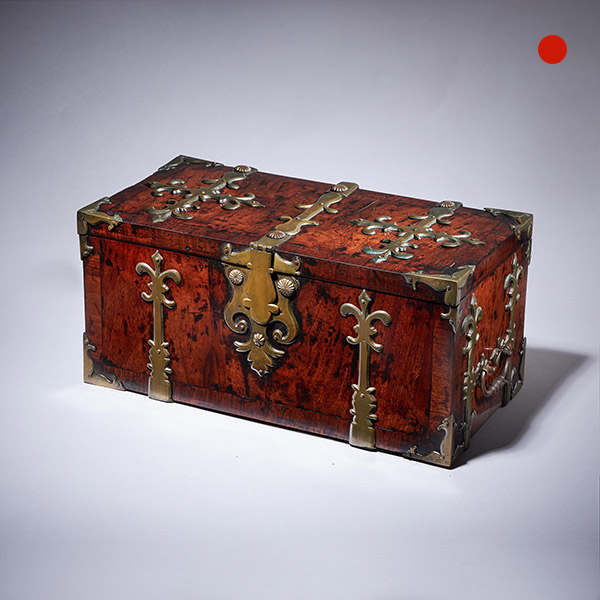
17th Century William & Mary Walnut Strongbox or Coffre Fort, Circa 1680-1700
17th Century William & Mary Walnut Strongbox or Coffre Fort, Circa 1680-1700 Sold Follow Us17th Century William & Mary Walnut Strongbox or Coffre Fort, Circa 1680-1700 17th century William and Mary Period walnut strongbox or coffre...
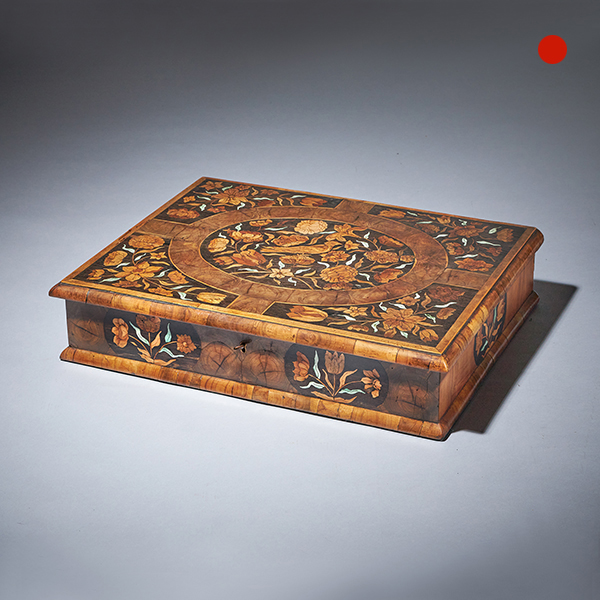
17th Century Museum Grade William and Mary Olive Oyster Marquetry Lace Box
17th Century Museum Grade William and Mary Olive Oyster Marquetry Lace Box Sold Follow Us17th Century Museum Grade William and Mary Olive Oyster Marquetry Lace Box 17th century Museum Grade William and Mary Olive Oyster Marquetry Lace box, C....
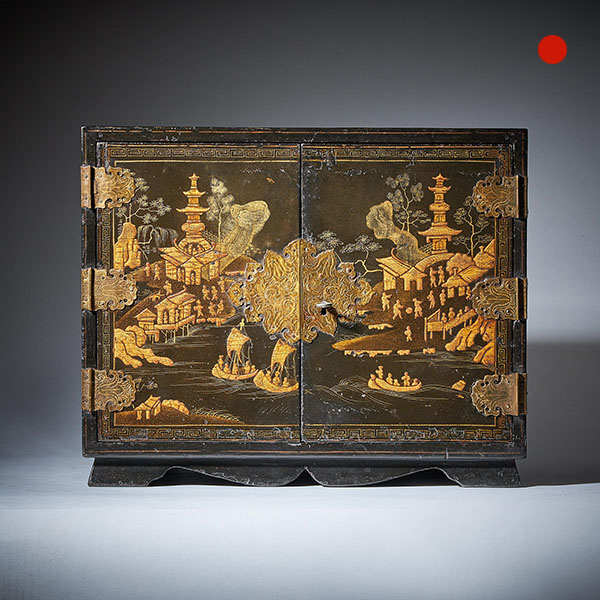
18th Century Chinese Export Lacquer Chinoiserie Table Cabinet
18th Century Chinese Export Lacquer Chinoiserie Table Cabinet SoldFollow Us18th Century Chinese Export Lacquer Chinoiserie Table Cabinet Depicting figurative scenes to all planes and opening on engraved strap hinges to a fitted interior of...
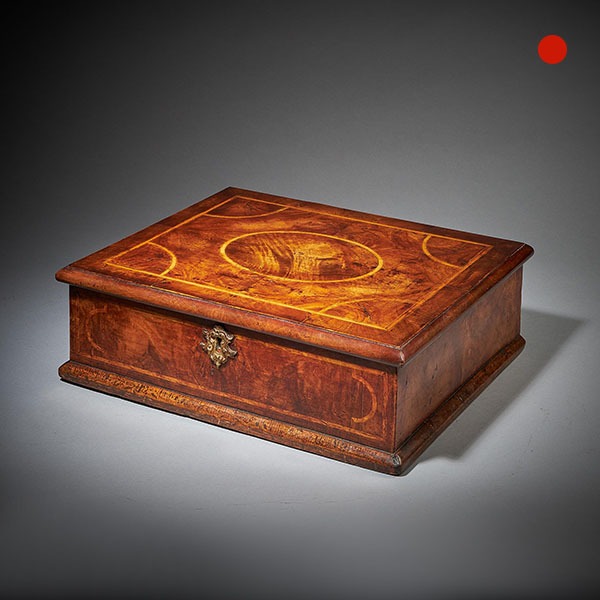
A Rare Figured Walnut Queen Anne – George I Lace Box, circa 1700-1720.
A Rare Figured Walnut Queen Anne - George I Lace Box, circa 1700-1720. SoldFollow UsA Rare Figured Walnut Queen Anne - George I Lace Box, circa 1700-1720. A rare figured walnut Queen Anne - George I period lace box, circa 1700-1720. The...
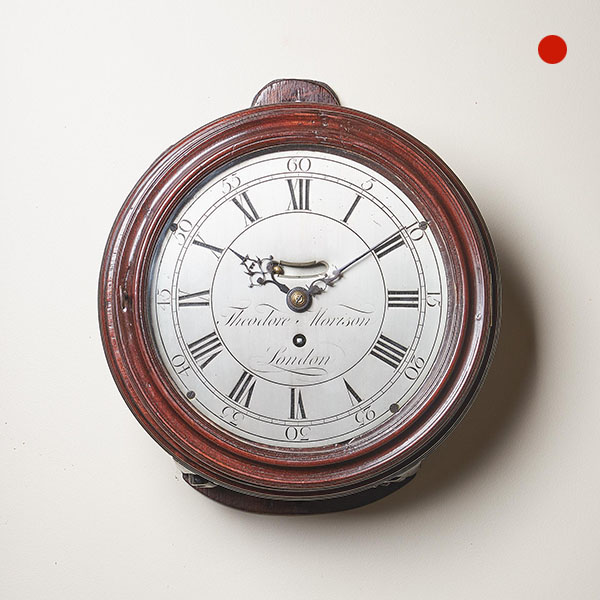
18th-Century George III Mahogany Eight-Day 8″ Silver Dial Clock by T.M London
18th-Century George III Mahogany Eight-Day 8" Silver Dial Clock by T.M London Sold Follow Us18th-Century George III Mahogany Eight-Day 8" Silver Dial Clock by T.M London A Rare 18th-Century Georgian English 8" Dial Clock / Wall Clock, by...
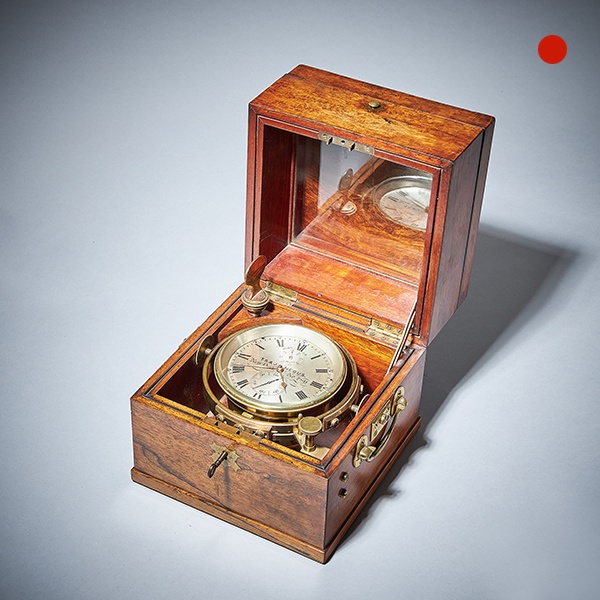
Fine American Two Day Marine Chronometer, Signed T. S & J. D Negus New York
Fine American Two Day Marine Chronometer, Signed T. S & J. D Negus New York SoldFollow UsFine American Two Day Marine Chronometer, Signed T. S & J. D Negus New York A Classic beautifully produced mid-19th century American chronometer...

17th Century William & Mary Walnut Strongbox or Coffre Fort, Circa 1680-1700
17th Century William & Mary Walnut Strongbox or Coffre Fort, Circa 1680-1700 Sold Follow Us17th Century William & Mary Walnut Strongbox or Coffre Fort, Circa 1680-1700 17th century William and Mary Period walnut strongbox or coffre...

17th Century Museum Grade William and Mary Olive Oyster Marquetry Lace Box
17th Century Museum Grade William and Mary Olive Oyster Marquetry Lace Box Sold Follow Us17th Century Museum Grade William and Mary Olive Oyster Marquetry Lace Box 17th century Museum Grade William and Mary Olive Oyster Marquetry Lace box, C....

18th Century Chinese Export Lacquer Chinoiserie Table Cabinet
18th Century Chinese Export Lacquer Chinoiserie Table Cabinet SoldFollow Us18th Century Chinese Export Lacquer Chinoiserie Table Cabinet Depicting figurative scenes to all planes and opening on engraved strap hinges to a fitted interior of...

A Rare Figured Walnut Queen Anne – George I Lace Box, circa 1700-1720.
A Rare Figured Walnut Queen Anne - George I Lace Box, circa 1700-1720. SoldFollow UsA Rare Figured Walnut Queen Anne - George I Lace Box, circa 1700-1720. A rare figured walnut Queen Anne - George I period lace box, circa 1700-1720. The...

18th-Century George III Mahogany Eight-Day 8″ Silver Dial Clock by T.M London
18th-Century George III Mahogany Eight-Day 8" Silver Dial Clock by T.M London Sold Follow Us18th-Century George III Mahogany Eight-Day 8" Silver Dial Clock by T.M London A Rare 18th-Century Georgian English 8" Dial Clock / Wall Clock, by...

Fine American Two Day Marine Chronometer, Signed T. S & J. D Negus New York
Fine American Two Day Marine Chronometer, Signed T. S & J. D Negus New York SoldFollow UsFine American Two Day Marine Chronometer, Signed T. S & J. D Negus New York A Classic beautifully produced mid-19th century American chronometer...
YOU MAY ALSO LIKE
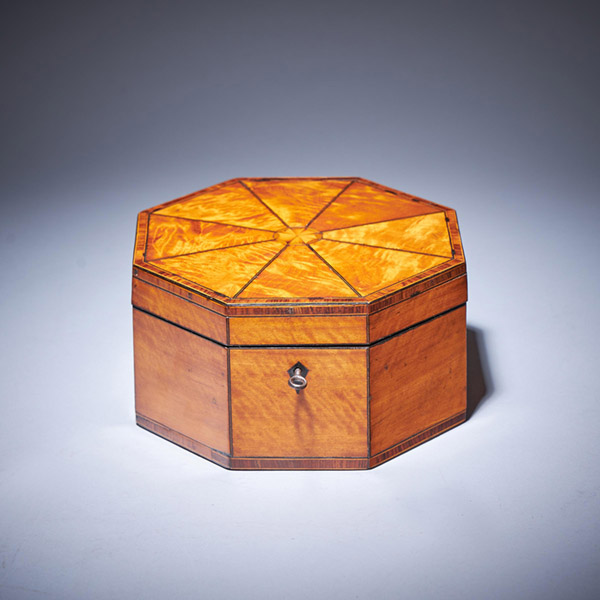
A Fine and Rare Late 18th Century George III Satinwood Octagonal Box, C.1790.
A Fine and Rare Late 18th Century George III Satinwood Octagonal Box, C.1790. £2,200[wpforms_selector form_id="11387" _builder_version="4.22.1" _module_preset="default" custom_margin="-30px||||false|false" hover_enabled="0"...
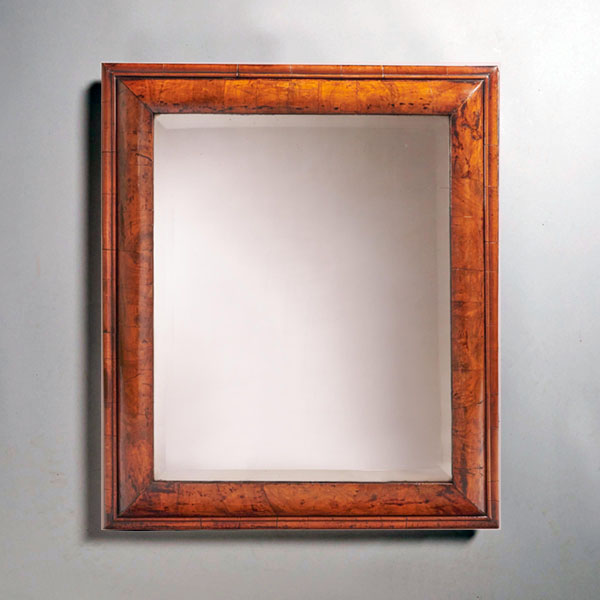
A Fine William and Mary 17th Century Figured Walnut Cushion Mirror C, 1690
A Fine William and Mary 17th Century Figured Walnut Cushion Mirror C, 1690 £6,500Follow UsA Fine William and Mary 17th Century Figured Walnut Cushion Mirror C, 1690 A large William and Mary 17th century figured walnut cushion mirror, circa...
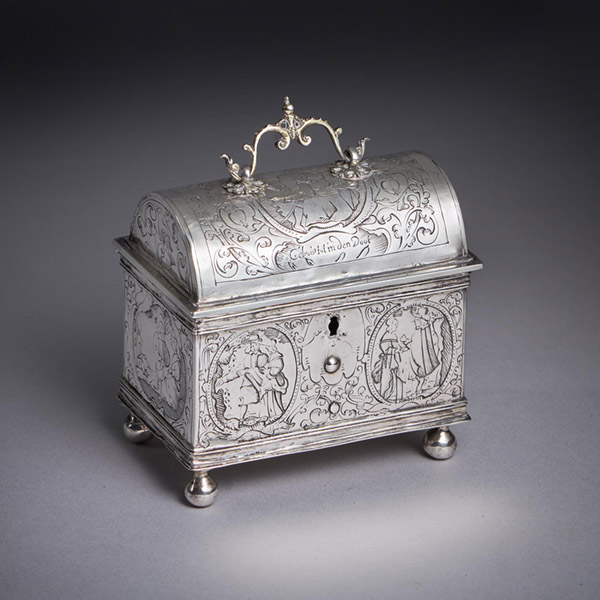
A museum-grade mid-17th century Dutch silver marriage casket or knottekistje, circa 1660
A museum-grade mid-17th century Dutch silver marriage casket or knottekistje, circa 1660 £9,500 [wpforms_selector form_id="11387" show_title="on" _builder_version="4.22.1" _module_preset="default" custom_margin="-30px||||false|false"...
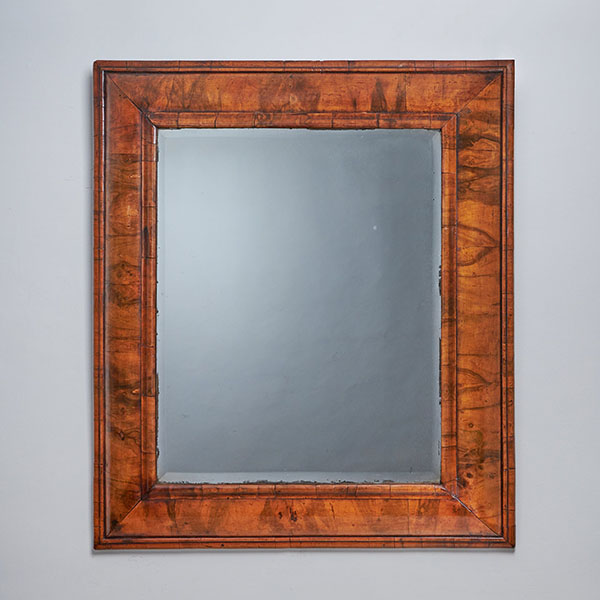
Large William and Mary 17th Century Figured Walnut Cushion Mirror c, 1690
Large William and Mary 17th Century Figured Walnut Cushion Mirror c, 1690 £7,495[wpforms_selector form_id="11387" show_title="on" _builder_version="4.22.1" _module_preset="default" custom_margin="-30px||||false|false" global_colors_info="{}"...
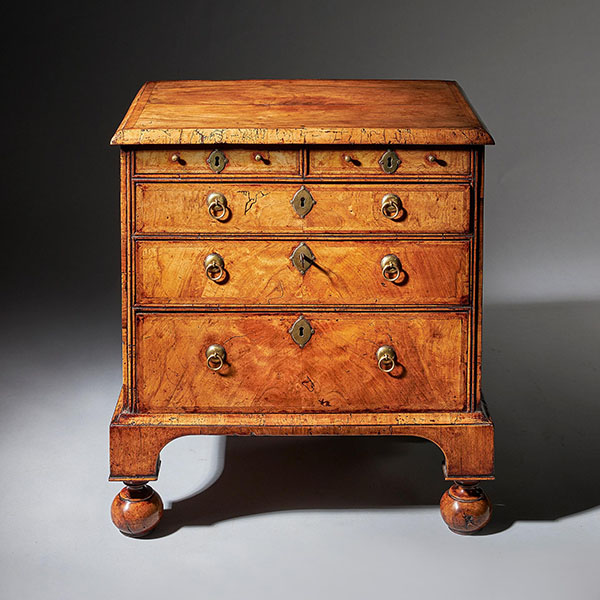
An extremely rare George I walnut chest of small proportions on ball and bracket
An extremely rare George I walnut chest of small proportions on ball and bracket £18,800[wpforms_selector form_id="11387" show_title="on" _builder_version="4.22.1" _module_preset="default" custom_margin="-30px||||false|false"...
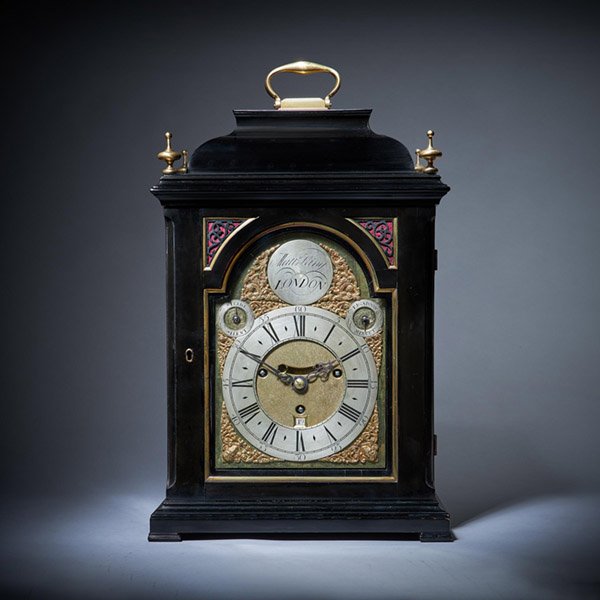
A Rare 18th Century George II Musical Table Clock by Matthew King, c. 1735.
A Rare 18th Century George II Musical Table Clock by Matthew King, c. 1735. £24,500[wpforms_selector form_id="11387" show_title="on" _builder_version="4.22.1" _module_preset="default" custom_margin="-30px||||false|false"...

A Fine and Rare Late 18th Century George III Satinwood Octagonal Box, C.1790.
A Fine and Rare Late 18th Century George III Satinwood Octagonal Box, C.1790. £2,200[wpforms_selector form_id="11387" _builder_version="4.22.1" _module_preset="default" custom_margin="-30px||||false|false" hover_enabled="0"...

A Fine William and Mary 17th Century Figured Walnut Cushion Mirror C, 1690
A Fine William and Mary 17th Century Figured Walnut Cushion Mirror C, 1690 £6,500Follow UsA Fine William and Mary 17th Century Figured Walnut Cushion Mirror C, 1690 A large William and Mary 17th century figured walnut cushion mirror, circa...

A museum-grade mid-17th century Dutch silver marriage casket or knottekistje, circa 1660
A museum-grade mid-17th century Dutch silver marriage casket or knottekistje, circa 1660 £9,500 [wpforms_selector form_id="11387" show_title="on" _builder_version="4.22.1" _module_preset="default" custom_margin="-30px||||false|false"...

Large William and Mary 17th Century Figured Walnut Cushion Mirror c, 1690
Large William and Mary 17th Century Figured Walnut Cushion Mirror c, 1690 £7,495[wpforms_selector form_id="11387" show_title="on" _builder_version="4.22.1" _module_preset="default" custom_margin="-30px||||false|false" global_colors_info="{}"...

An extremely rare George I walnut chest of small proportions on ball and bracket
An extremely rare George I walnut chest of small proportions on ball and bracket £18,800[wpforms_selector form_id="11387" show_title="on" _builder_version="4.22.1" _module_preset="default" custom_margin="-30px||||false|false"...

A Rare 18th Century George II Musical Table Clock by Matthew King, c. 1735.
A Rare 18th Century George II Musical Table Clock by Matthew King, c. 1735. £24,500[wpforms_selector form_id="11387" show_title="on" _builder_version="4.22.1" _module_preset="default" custom_margin="-30px||||false|false"...













